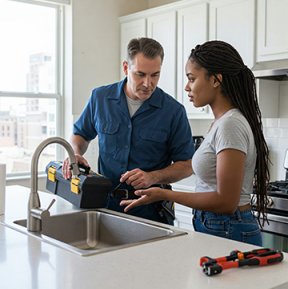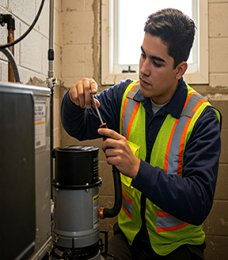Published: September 25, 2015 | Updated: September 19, 2025
Published: September 25, 2015 | Updated: September 19, 2025
Beyond Leaks: How a CMMS Transforms Facility Management
 Facility managers navigate a complex landscape, balancing routine upkeep, preventative measures, and the constant vigilance required to keep operations running smoothly. Overlooking seemingly minor details can quickly escalate into costly disruptions. While plumbing issues represent a tangible and often expensive category of potential problems, the tools employed to mitigate these risks offer far-reaching benefits across the entire facility. Let's look at how a Computerized Maintenance Management System (CMMS) transforms facility management in this area.
Facility managers navigate a complex landscape, balancing routine upkeep, preventative measures, and the constant vigilance required to keep operations running smoothly. Overlooking seemingly minor details can quickly escalate into costly disruptions. While plumbing issues represent a tangible and often expensive category of potential problems, the tools employed to mitigate these risks offer far-reaching benefits across the entire facility. Let's look at how a Computerized Maintenance Management System (CMMS) transforms facility management in this area.
Centralizing Maintenance Information
At its core, a CMMS provides a centralized platform for managing all maintenance-related activities and information. This digital hub replaces disparate spreadsheets, paper-based systems, and individual knowledge silos with a unified database.
Imagine a scenario where a technician needs to locate the maintenance history of a specific HVAC unit or identify the warranty information for a piece of critical machinery. Without a CMMS, this search can involve sifting through numerous files and contacting multiple individuals, consuming valuable time and potentially delaying necessary repairs. A CMMS eliminates this inefficiency by offering instant access to asset details, maintenance logs, vendor information, and associated documentation.
Proactive Maintenance Strategies
The reactive approach to maintenance–fixing equipment only when it breaks down–often leads to:
- Unexpected costs in labor (overtime); in resources (emergency purchases of parts/supplies); in lost time (when production halts); in reputation (when you can't meet deadlines or delivery schedules).
- Operational downtime.
- Premature asset failure and complete breakdown because of consistent lack of preventive maintenance. Each incident risks depleting the reliability of the asset a bit each time.
- Lower employee morale because of continual downtime issues.
- Safety problems. Failures or breakdowns risk employee safety.
A CMMS facilitates a shift towards proactive maintenance strategies, most notably preventative maintenance (PM). Facility managers can schedule recurring maintenance tasks based on time intervals, usage metrics, or condition monitoring data. The system allows maintenance supervisors to create lists of PMs, convert them to work orders, prioritize them, schedule them, and dispatch the jobs.
Plumbing Preventive Maintenance from a CMMS
For plumbing systems in a facility, a Computerized Maintenance Management System (CMMS) can help schedule and track various preventative maintenance (PM) tasks. These PMs aim to identify and address potential issues before they escalate into costly repairs or disruptions. Here are some examples of plumbing PMs that might be scheduled:
Daily/Weekly Checks:
- Leak Inspections: Regularly check visible pipes, faucets, showerheads, and connections for any signs of leaks, drips, or moisture. Early detection can prevent water damage and conserve water. For example, a quick walk-through of restrooms and break rooms each morning can identify minor leaks.
- Fixture Functionality: Ensure all faucets turn on and off properly, showerheads have adequate flow, and toilets flush and refill correctly without running continuously. This prevents unnecessary water usage and identifies potential valve or component failures.
- Drain Operation: Verify that sinks and floor drains are draining freely and not showing signs of slow drainage, which could indicate a developing clog.
- Unusual Noises: Listen for unusual sounds like gurgling, banging, or whistling from pipes or fixtures, which can signal underlying problems like air in the lines, water hammer, or blockages.
- Temperature Checks: Confirm that hot and cold water are reaching the expected temperatures at various outlets. This can indicate issues with the water heater or mixing valves.
Monthly/Quarterly Tasks:
- Drain Cleaning: Implement a schedule for regular cleaning of drains in high-use areas like kitchens and restrooms. This can involve using enzymatic cleaners or mechanical methods like snaking to prevent buildup of grease, food particles, and other debris. For instance, a restaurant might schedule drain cleaning in the kitchen every month.
- Faucet Aerator and Showerhead Cleaning: Remove and clean faucet aerators and showerheads to remove mineral buildup (calcium, lime) that can restrict water flow and affect spray patterns. Soaking them in vinegar can dissolve these deposits.
- Visible Pipe Inspection: Conduct a more thorough inspection of all accessible pipes for signs of corrosion, rust, or physical damage. Catching these issues early can prevent leaks and potential pipe failures.
- Toilet Tank Inspection: Check the components within the toilet tank, such as the flapper, fill valve, and flush valve, for wear and tear, leaks, or improper operation. Adjust or replace parts as needed to ensure efficient flushing and prevent water waste.
- Water Heater Inspection: Visually inspect the water heater for leaks, rust, or corrosion. Check the temperature and pressure relief valve to ensure it's functioning correctly.
Semi-Annual/Annual Tasks:
- Water Heater Flushing: Drain and flush the water heater to remove sediment buildup. Sediment accumulation can reduce heating efficiency, increase energy costs, and shorten the lifespan of the water heater.
- Pressure Relief Valve Testing (Water Heater): Test the pressure relief valve on the water heater to ensure it can release excess pressure safely.
- Backflow Preventer Testing: If the facility has backflow preventers (required in many commercial settings to protect the potable water supply), schedule annual testing by a certified professional to ensure they are functioning correctly.

- Sump Pump Inspection (if applicable): For facilities with basements or areas prone to flooding, inspect and test the sump pump to ensure it's operational and the discharge line is clear.
- Shut-Off Valve Testing: Exercise all accessible water shut-off valves (under sinks, toilets, and main building shut-off) to ensure they are not seized or corroded and can be closed in an emergency.
- Plumbing System Inspection: Conduct a comprehensive inspection of the entire plumbing system, including pipes in less accessible areas, by a qualified plumber. This can identify potential issues that might not be apparent during routine checks.
- Septic System Maintenance (if applicable): For facilities with septic systems, schedule regular inspections and pumping according to the manufacturer's recommendations and local regulations.
- Water Pressure Testing: Check the overall water pressure of the facility to ensure it's within the acceptable range. High pressure can strain pipes and fixtures, while low pressure can affect usability.
Discover how streamlined maintenance processes can elevate production. Learn more.
Efficient Work Order Management
A CMMS streamlines the entire work order lifecycle, from initial request to completion and closure. Employees can submit maintenance requests through the system, providing detailed information about the issue. You can add checklists and attachments to the work orders. Managers gain real-time visibility into the status of all work orders, allowing them to track progress, prioritize tasks, and allocate resources effectively.
Since many of the jobs cover a lot of territory, mobile access capabilities further enhance efficiency by enabling technicians to receive assignments, update work order status, and access asset information directly from their mobile devices while in the field. This eliminates the need for manual paperwork and reduces communication delays, leading to faster resolution times and improved overall productivity.
Comprehensive Asset Management
A CMMS serves as a comprehensive asset management tool, providing a detailed inventory of all facility assets, from major equipment to smaller components. This centralized asset register provides valuable insights into asset performance, lifecycle costs, and potential replacement needs. Facility managers can generate reports to analyze asset reliability, identify underperforming equipment, and make data-driven decisions regarding capital expenditures.
For instance, tracking the maintenance history of several similar pumps through the CMMS might reveal that one particular model consistently requires more frequent repairs, prompting a review of its suitability for the application or consideration of alternative, more reliable options.
Inventory and Spare Parts Management
A CMMS organizes inventory management auto-tracking of quantity, location, and usage of spare parts. The system can automatically generate a purchase request when stock levels fall below predefined thresholds, preventing delays caused by the unavailability of necessary components. This capability extends beyond plumbing-related items to encompass spare parts for HVAC systems, electrical equipment, and other critical assets.
Reporting and Analytics for Continuous Improvement
The data captured within a CMMS provides valuable insights into maintenance performance and overall facility operations. Beyond the standard key performance indicator reports, you have inventory reports, labor/work order statistics, and costs for the input data. Analyzing these reports helps identify areas for improvement, track the effectiveness of maintenance strategies, and justify resource allocation decisions.
In conclusion, the capabilities of a CMMS extend far beyond preventing leaks and clogs. This technology acts as a central nervous system for facility operations, empowering teams with the information and tools they need to manage assets effectively, execute maintenance proactively, and make informed decisions that contribute to the long-term health and efficiency of the entire facility. Embracing a CMMS represents a strategic investment in operational excellence, fostering a more controlled, predictable, and ultimately successful facility management future.
FAQs
What is a CMMS and how does it help facility management?
A CMMS (Computerized Maintenance Management System) centralizes maintenance data, streamlines work orders, and improves asset reliability across facilities.
How does a CMMS support preventive maintenance in plumbing systems?
It schedules recurring tasks such as leak inspections, drain cleaning, water heater flushing, and shut-off valve testing to prevent costly breakdowns.
Why is proactive maintenance better than reactive maintenance?
Proactive maintenance reduces downtime, prevents asset failures, lowers emergency costs, improves safety, and boosts employee morale.
Can MAPCON CMMS improve plumbing maintenance efficiency?
Yes, MAPCON CMMS helps track inspections, schedule tasks, and manage spare parts, ensuring plumbing systems operate smoothly.
How does CMMS work order management benefit facility teams?
It simplifies request submission, provides real-time job tracking, and enables mobile access for technicians, speeding up repairs and increasing productivity.
What insights can facility managers gain from CMMS reports?
CMMS analytics reveal asset performance, maintenance costs, recurring issues, and inventory needs, helping managers make data-driven decisions.
MAPCON | 800-922-4336
MAPCON CMMS software empowers you to plan and execute PM tasks flawlessly, thanks to its wealth of features and customizable options. Want to see it for yourself? Click the button below to get your FREE 30-day trial of MAPCON!
Try It FREE!